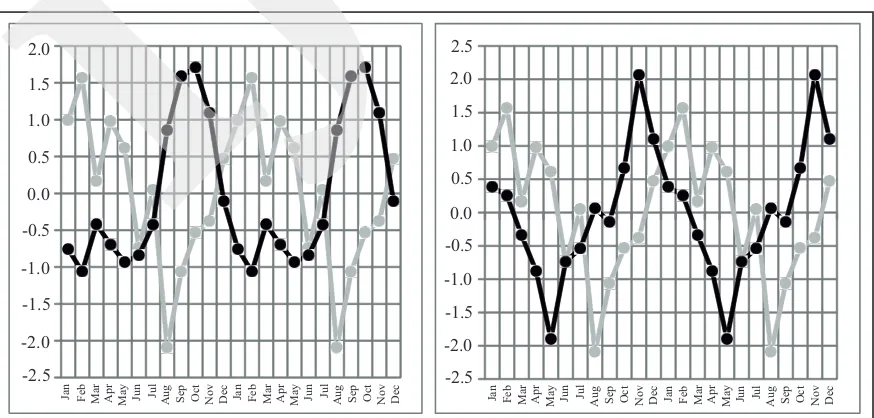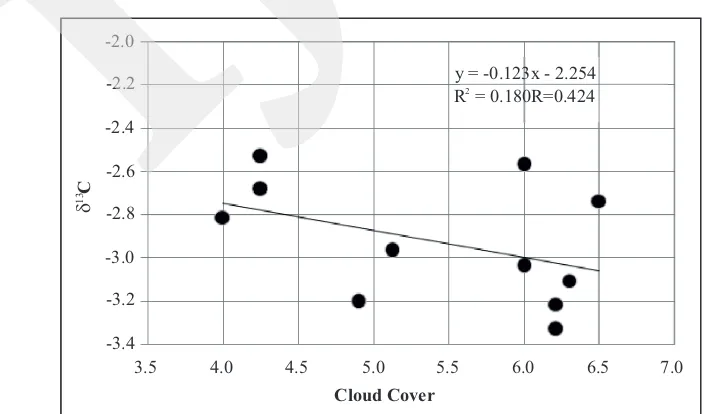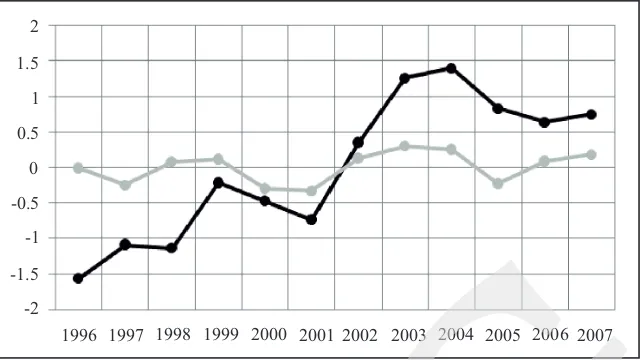INDONESIAN JOURNAL ON GEOSCIENCE
Geological AgencyMinistry of Energy and Mineral Resources
Journal homepage: h�p://ijog.bgl.esdm.go.id ISSN 2355-9314 (Print), e-ISSN 2355-9306 (Online)
IJOG/JGI (Jurnal Geologi Indonesia) - Acredited by LIPI No. 547/AU2/P2MI-LIPI/06/2013, valid 21 June 2013 - 21 June 2016
Seasonal variation of δ
13C content in
Porites
coral from Simeulue Island
waters for the period of 1993-2007
Sri Yudawati Cahyarini
Research Centre for Geotechnology LIPI, Kompleks LIPI, Jln. Sangkuriang, Bandung
Corresponding author: yuda@geotek.lipi.go.id
Manuscript received: March 27, 2014, revised: April 2, 2014, approved: July 14, 2014
Abstract - Variation of δ13C content in coral skeletons shows the influence of metabolic fractionation in aragonite coral.
Understanding coral δ13C variation can thus be useful to more understand e.g. past bleaching event which is further
useful for coral health and conservation. In this study, δ13C content in Porites coral from Labuhan Bajau, Simeulue
Islands was analyzed. To know the correlation between variation of coral δ13C and light intensity, the monthly varia
-tion of coral δ13C is compared to solar radiation and cloud cover. The result shows that for the period of 2003 to 2008,
coral δ13C shows it is well correlated (r=0.42 p=0.153) with cloud cover variation in annual mean scale. Meanwhile, in
seasonal mean variation, coral δ13C is strongly influenced (r=0.85 p<0.0001) by cloud cover with 1 - 2 month time lag.
Comparing to the solar radiation (cloud cover), SST influences dominantly the variation of coral δ13C from southern
Simeulue Island waters (LB sample) in an annual mean scale than in a seasonal scale.
Keywords: δ13C, coral, Porites, solar radiation, cloud cover, SST
Introduction
A study of stable carbon isotopic composition (δ13C) content in coral skeletons shows that δ13C composition is primarily influenced by metabolic fractionation (e.g. McConnaughey, 1989; Grot
-toli, 2002) i.e. influenced by photosynthesis and respiration (McConnaughey,1989; Grottoli, 2002, in Rodrigues and Grottoli, 2006). Decreased coral δ13C coinciding with bleached coral (Porter et al.,1989, in Rodrigues and Grottoli, 2006) is due to decreased photosynthesis, while increased zooplankton decreased δ13C is via respiration (Felis et al.,1998; Grottoli and Wellington, 1999, in Rodrigues and Grottoli, 2006).
Understanding δ13C content in coral skeleton is useful to more understand a physiological factor which is a base to more understand the bleaching event and further to the coral health and conservation (Rodrigues and Grottoli, 2006). In this study, δ13C content in Porites coral from
Labuhan Bajo Simeulue waters was analyzed. Monthly variation of coral δ13C is compared to the solar radiation and cloud cover to understand the influence of light intensity to the coral δ13C. This study can be as a base for a historical coral development study for a longer time window, i.e. hundreds to thousands year ago. Further, the study is able to support the coral reef conservation activities in the Simeulue ocean waters.
Materials and Methods
Porites coral core was collected in July 2007 from 25 m depth of Labuhan Bajo Vil
coral slabs were then used to perform the coral banding (Figure 1). Subsampling using hand drilling (1 mm bit) was done along the coral growth axis to get the coral powder samples. Coral powder samples were then analyzed for δ13C using Gasbench Delta Plus at the Free University Amsterdam. The powdered samples were reacted with H3PO4, and the resulting CO2 gas was analyzed in the mass spectrometer. All samples are reported in ‰.
Coral XDS software was used to calculate the paired high/low density which was used to de
-veloped preliminary chronology in annual scale. One year growth is represented by a dark and light coral band in x -rayed coral. The detailed chronol
-ogy (i.e. monthly scale) of δ13C is based on coral Sr/Ca chronology development (see Cahyarini, 2011). Paired density band calculation result in that LB Porites coral is about ~14 years old. The chronology development of coral δ13C results in period ranges from July 1993 to August 2007. Monthly variation of δ13C from Porites coral (sample code LB) for the period of 1993-2007 is shown in Figure 2.
solar radiation, cloud cover, and coral SST. Solar radiation data are obtained from Fresco v.6 aver
-aged over 2x2 grid boxes resolution (from Wang et al., 2008) and available from 2002- 2007. Cloud cover data are obtained from ICOADS with 2x 2 grid resolution and available from 1996-2007. Variable cldc (Cloudiness Monthly Mean at Surface) is in okta. ICOADS data provided by the NOAA/OAR/ESRL PSD, Boulder, Colorado, USA, from their Web site at http://www.esrl.noaa. gov/psd/.
SST derived from coral Sr/Ca (further men
-tioned as coral SST) was used in this study to indicate the influence of SST to the variation of coral δ13C. Coral SST is obtained from Cahyarini, (2011).
Results and Discussions
The analysis of δ13C content in coral skeleton sample LB using Gasbench Delta Plus in monthly resolution is shown in Figure 2. Monthly variation of coral δ13C (Figure 2) ranges from -3.39±0.42‰ to -2.07±0.42‰ with the mean value -2.98±0.42‰ for the period of 1993-2007. For the period of 2003 to 2008, decreasing trend of solar radiation supposes decreasing trend of coral δ13C from this region (Figure 3), which confirms the published work i.e. for the healthy coral as solar radiation decrease, decreased coral δ13C is due to decreasing
Figure 1. X -Rayed of Porites coral slab sample LB. Dashed
lines are subsampling transect along the growth axis.
Figure 2. Monthly variation of δ13C content in Porites coral (sample code LB) from Labuhan Bajo.
Top Bottom
-2.0
-2.5
-3.0
-3.5
-4.0
-4.5
1994
1993 1995 1996 1997 1998 1999 2000 2001 2002 2003 2004 2005 2006 2007
photosynthesis (Grottoli, 2002; Heikoop et al., 2002). In some year periods, the seasonal cycles of δ13C shows out of phase compared to solar radia -tion seasonal cycles, i.e. from 2005 to 2007, when the high solar radiation coincides with low δ13C. This suggests that this period coincided with the weak ENSO event when the seawater temperature anomaly slowed down the enrichment of δ13C in the coral skeletons. During the normal condition, coral δ13C enrichment normally follows the solar radiation cycle.
Seasonal mean variation of solar radiation varies out of phase with the cloud cover, i.e. high
Figure 3. Graphic of monthly variation of coral δ13C (grey line) and solar radiation (dark line) and its trend lines (bold grey
and dark lines).
Figure 4. Graphic of monthly mean variation of solar radiation (grey line) and (left) cloud cover (dark line) and (right) δ13C
(dark line). The data are corrected for two month lag. All time series data are standardized.
0.00
2002 2003 2004 2005 2006 2007
d13C
solar radiation coincides with low cloud cover (Figure 4). In the studied areas, the maximum solar radiation is in February (641.25 w/m2) and the minimum is in August (495.09 w.m2), while cloud cover maximum is in October (0.45) and minimum is in Februari (0.27). Seasonal mean variation of solar radiation and δ13C coral shows a good correlation in 1 month time lag. The maxi
-mum δ13C is in November and the minimum is in May. Figure 4 shows monthly mean variation of solar radiation, cloud cover, and δ13C coral. Solar radiation supposes some time to reach the coral in 25 depths to influence its δ13C variation.
2.5
Jan Feb Mar Apr May Jun Jul Aug Sep Oct Nov Dec Jan Feb Mar Apr May Jun Jul Aug Sep Oct Nov Dec
2.0
Jan Feb Mar Apr May Jun Jul Aug Sep Oct Nov Dec Jan Feb Mar Apr May Jun Jul Aug Sep Oct Nov Dec
ing light condition may be caused by increasing cloud cover, which causes decreasing δ13C in coral skeletons. Decreasing δ13C content in Simeulue coral is supposed to relate to decreasing light in the depth of Porites coral (LB). This is convinced that the maximum δ13C amount in coral skeletons occurred during a maximum light.
An annual mean δ13C of LB coral sample and cloud cover are compared (Figure 5). The result shows that during ~10 years, from period of 1996 to 2007, decreasing trend of δ13C coral follows increasing trend of cloud cover. Correlation between these two series convinces that annual
Figure 5. Annual mean variation of δ13C (grey line) and cloud cover (dark line). Linear trend line (dashed line). Data are
standardized to unit variance.
Figure 6. Linear regression of cloud cover and δ13C in the annual mean scale.
cover (r=0.424 p=0.169) (Figure 6). The variation of coral δ13C relative to cloud cover variation is about 0.123‰/okta (0 clear cloud to 8 overcast).
It suggests that the clearer the cloud, the more δ13C content in coral.
Sr/Ca content in LB coral shows a local sea surface temperature (SST) at a coral site (Cahya
-rini, 2011). Reconstructed SST based on Sr/Ca content in LB coral (further mentioned as coral SST) (Cahyarini, 2011) was used to understand the influence of SST to the variation of coral δ13C. Coral SST was compared and correlated with coral δ13C (Figure 7). The result shows that
-0.5
-1 -1.5
-2 0 0.5 1 1.5 2
2002 2001 2000
1996 1997 1998 1999 2003 2004 2005 2006 2007
7.0 6.5
6.0 5.5
5.0 4.5
4.0 3.5
-3.4 -3.2 -3.0 -2.8 -2.6 -2.4 -2.2 -2.0
C
Cloud Cover
y = -0.123x - 2.254 R = 0.180R=0.4242
Figure 7. Annual mean variation of coral δ13C (dark line) and SST (grey line) derived from coral Sr/Ca. Data are standard
-ized to unit variance.
in annual mean resolution, correlation between coral SST and δ13C is high (r=0.54 p=0.057). It suggests that the influence of SST to the varia
-tion of δ13C is higher than that with cloud cover (solar radiation) in annual mean scale. In seasonal variation, coral δ13C change respond to SST is low (r=0.387 p<0.0001). It supposes the SST varia
-tion is dominant in changing the δ13C content in LB coral in the annual mean scale rather than in
seasonal scale.
Conclusions
The δ13C variation content in coral from Labuhan Bajo (LB) east –southern Simeulue Island is well correlated with cloud cover variation in annual mean scale. In seasonal scale, variation of δ13C content in LB coral is influenced by cloud cover with 1-2 month time lag. Variation of coral δ13C is dominantly influenced by SST in annual mean than in seasonal variation.
Acknowledgements
The author acknowledges the KNAW Mobility Program 2007/08 -grant to SYC for the isotope analysis at the Isotope laboratorium facilities at Vrije University, Amsterdam.
1996 1997 1998 1999 2003 2004 2005 2006 2007
References
Cahyarini, S.Y., 2011. Rekonstruksi suhu per
-mukaan laut periode 1993-2007 berdasarkan analisis kandungan Sr/Ca koral dari wilayah Labuan Bajo, Pulau Simeulue. Jurnal Geologi Indonesia, 6 (3), p.129-134.
Felis, T., Patzold, J., Loya, Y., and Wefer, G., 1998. Vertical water mass mixing and plank
-ton blooms recorded in skeletal stable carbon isotopes of a Red Sea coral. Journal of Geo-physicalResearch,103 (30), p.730-731. Grottoli, A.G. and Wellington, G.M., 1999. Ef
-fect of life and zooplankton on skeletal d13C values in the eastern Pacific corals Pavona clavus and Pavona gigantean. Coral Reefs,18, p.29-41.
Grottoli, A.G., 2002. Effect of life and bring shrimp on skeletal d13C in the Hawaiian coral Porites compressa: a tank experiment. Geochi-mica et CosmochiGeochi-mica Acta, 66, p.1955-1967. Heikoop, J.M., Hickmott, D.D., Risk, M.J.,
Shearer,C.K., and Atudorei,V., 2002. Potential climate signals from the deep sea gorgonian coral Primnoa resedaeformis. Hydrobiologia, 471, p.117-124.
McConnaughey, T., 1989. 13C and 18O isotopic disequilibrium in biological carbonates: II In Vitro simulation of kinetic isotope effect. Geochimica et Cosmochimica Acta, 53, p.163-171.
C.S., and White, M.W., 1989. Bleaching in reef corals: physiological and stable isotopic responses. Proceedings of Natural Academic Science,USA, 86, p.9342-9346.
Rodrigues, L.J. and Grottoli, A.G., 2006. Calcifi
-cation rate and the stable carbon, oxygen, and nitrogen isotopes in the skeleton, host tissue, and zooxanthellae of bleached and recovering
mica Acta, 70, p.2781-2789, doi 10.1016/j.
gca.2006.02.014.
Wang, P., Stammes, R. van der A.P., Pinardi, G., and Roozendael, M. van, 2008. FRESCO+: an improved O2 A-band cloud retrieval algorithm for tropospheric trace gas retriev -als. Atmospheric Chemistry and Physics, 8, p.6565-6576.



